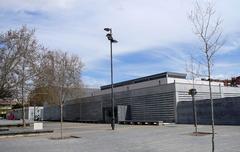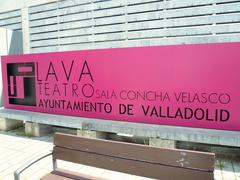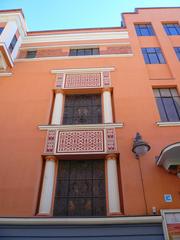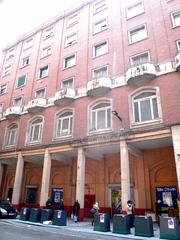Vivero Palace Valladolid: Visiting Hours, Tickets, and Historical Sites Guide
Date: 04/07/2025
Introduction: The Historical Significance of Vivero Palace
Located in the heart of Valladolid, Spain, Vivero Palace (Palacio de los Vivero) is a monument steeped in the country’s medieval and Renaissance history. Commissioned in the 15th century by Alonso Pérez de Vivero, this palace began as a fortified noble residence and later became a center of royal justice and administration. It is most renowned as the site of the pivotal marriage contract between Isabella I of Castile and Ferdinand II of Aragon in 1469—a union that initiated the unification of Spain and the start of its Golden Age. Today, visitors can admire the palace’s Gothic-Mudéjar architecture, especially the intricate “Sala Rica” ceiling, and experience layers of history as the building now houses the Provincial Historical Archive of Valladolid. This guide provides all essential information for planning a visit, including hours, tickets, accessibility, and tips for exploring nearby attractions (Valladolid Para Todos, myCityQuest).
Table of Contents
- Origins and Construction
- Architectural Features
- The Marriage of the Catholic Monarchs
- Judicial and Administrative Role
- Provincial Historical Archive and Preservation
- Visitor Information: Hours, Tickets, and Tours
- Accessibility and Visitor Amenities
- How to Get There
- Nearby Attractions
- Frequently Asked Questions (FAQ)
- Visual Resources and Media
- Conclusion
Origins and Construction of Vivero Palace
Commissioned around 1440 by Alonso Pérez de Vivero, a distinguished Castilian noble, Vivero Palace was designed as a fortified residence reflecting both the wealth and the turbulent political climate of 15th-century Castile. The palace features a rectangular courtyard surrounded by arcaded galleries—octagonal stone pillars on the lower level and plastered brick on the upper, topped with a wooden balustrade. The original complex included three interconnected buildings: the main palace, the Chancillería archive, and the old prison, forming a rare administrative and residential ensemble within Valladolid (Valladolid Para Todos).
Architectural Features
Vivero Palace is a remarkable example of late medieval Castilian architecture with Renaissance and Mudéjar influences. The main entrance opens into a vestibule designed for privacy, a feature inherited from Hispano-Muslim architectural traditions. Defensive elements such as crenellated walls and towers (partially demolished in 1475) reflect its original function as a fortress. The “Sala Rica,” with its Mudéjar coffered ceiling and intricate vegetal motifs, remains the architectural highlight. Later Renaissance additions by Luis de Vega include a Tuscan gallery and a tower adorned with imperial symbols (myCityQuest).
The Marriage of the Catholic Monarchs
The palace achieved national significance in 1469 when it hosted the marriage contract signing of Isabella I of Castile and Ferdinand II of Aragon. The event, which took place in the lavishly decorated “Sala Rica,” paved the way for the unification of Spain. The marriage was formalized after Cardinal Rodrigo Borgia (later Pope Alexander VI) delivered the necessary papal dispensation, cementing the palace’s place in Spanish history (Valladolid Para Todos).
Judicial and Administrative Role
Following its acquisition by the Catholic Monarchs in 1475, the palace’s defensive towers were removed to diminish noble power. The building was repurposed as the seat of the Royal Chancery, the highest court in Castile, from 1490 until the 19th-century judicial reforms. This function continued with the Audiencia Territorial de Valladolid until 1962, underscoring the palace’s central role in regional governance (Archivo Histórico Provincial de Valladolid).
Provincial Historical Archive and Preservation
Since the 1960s, Vivero Palace has served as the Provincial Historical Archive of Valladolid, safeguarding centuries of legal and administrative documents. A major restoration in 1993 preserved its medieval and Renaissance character, revealing original stonework and restoring features like the “Sala Rica” ceiling. The palace is classified as a Bien de Interés Cultural, ensuring its protection for future generations (Valladolid Para Todos).
Visitor Information: Hours, Tickets, and Tours
Hours:
- General opening: Tuesday to Saturday, 10:00 AM–2:00 PM; Sunday and public holidays, 10:00 AM–1:00 PM; closed Mondays.
- As an active archive, hours may vary—always check the archive’s official site or contact in advance.
Tickets:
- Admission is free for general visits. Guided tours or special events may require prior booking and a small fee.
Guided Tours:
- Available during heritage weeks, cultural events, or by group arrangement. Tours may be in Spanish or English, highlighting the palace’s history and architectural features.
Photography:
- Allowed in public areas; restrictions may apply in archive or special exhibition rooms. Flash and tripods are prohibited.
Accessibility and Visitor Amenities
The palace offers partial accessibility:
- The main entrance is at street level.
- Some interior areas and upper floors may be accessible only by stairs; there is no elevator due to the building’s protected status.
- Accessible restrooms are available.
- Visitors with reduced mobility should contact the archive in advance for assistance.
There is no on-site gift shop, but the historic center offers bookstores and souvenir shops nearby.
How to Get There
Location: Calle Ramón y Cajal nº 1, Valladolid, Spain
- By public transport: Several city bus lines stop nearby; the train station (Valladolid-Campo Grande) is a 20-minute walk or a short taxi ride away.
- Parking: No dedicated parking at the palace. Public garages and regulated street parking are available within a 10-minute walk.
- Cyclists: Public bike-sharing stations are available nearby.
Nearby Attractions
Make the most of your visit by exploring these nearby Valladolid historical sites:
- Plaza Mayor: Lively central square with arcades and cafes (The Crazy Tourist).
- Valladolid Cathedral: A striking Baroque structure.
- Church of San Pablo: Famous for its elaborate Gothic façade.
- National Sculpture Museum: Renowned for its collection of Spanish sculpture.
- Casa de Cervantes: The historic home of Don Quijote’s author.
Frequently Asked Questions (FAQ)
Q: What are the Vivero Palace visiting hours?
A: Tuesday to Saturday, 10:00 AM–2:00 PM; Sunday and public holidays, 10:00 AM–1:00 PM. Closed Mondays. Always confirm before visiting.
Q: Is there an entrance fee or are tickets required?
A: General admission is free; guided tours or special exhibitions may require a fee and advance booking.
Q: Are guided tours available?
A: Yes, during special events or by group appointment.
Q: Is Vivero Palace accessible for visitors with disabilities?
A: The main entrance is accessible, but interior mobility may be limited. Contact the archive for detailed information.
Q: Can I take photographs inside?
A: Photography is permitted in most public areas, but restrictions apply in archive rooms and during some events. No flash or tripods.
Q: Is parking available?
A: No on-site parking, but public garages are close by.
Visual Resources and Media
Enhance your visit with virtual tours and image galleries available through the Valladolid tourism website and the Audiala app. Use descriptive alt tags such as “Vivero Palace Gothic-Mudéjar ceiling” or “Valladolid historic courtyard” for accessible content.
Conclusion
Vivero Palace stands as a testament to Valladolid’s—and Spain’s—historic evolution. Its transition from noble residence and royal wedding site to a judicial and archival center illustrates the rich tapestry of the region’s past. The palace’s well-preserved Gothic-Mudéjar architecture, free public access, and central location make it a must-see for history enthusiasts and cultural travelers alike. Be sure to check current hours before visiting, consider joining a guided tour for deeper insights, and explore the wealth of cultural attractions nearby.
For up-to-date information, consult the official archive, Valladolid tourism, or myCityQuest.
Discover more about Valladolid’s heritage by exploring nearby monuments and using digital resources like the Audiala app, which offers guided tours and cultural insights.




